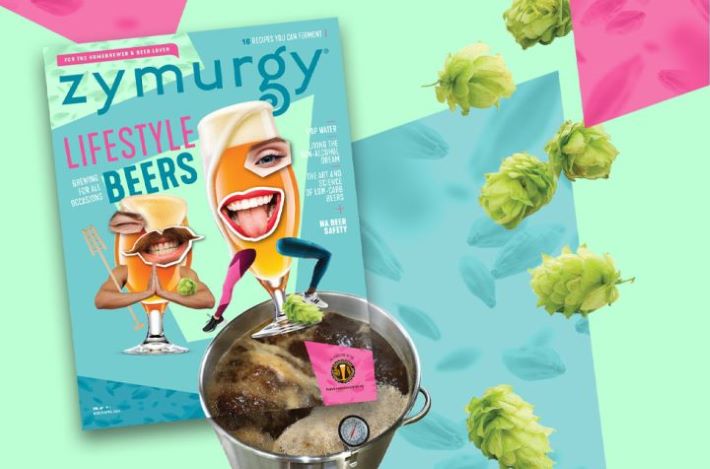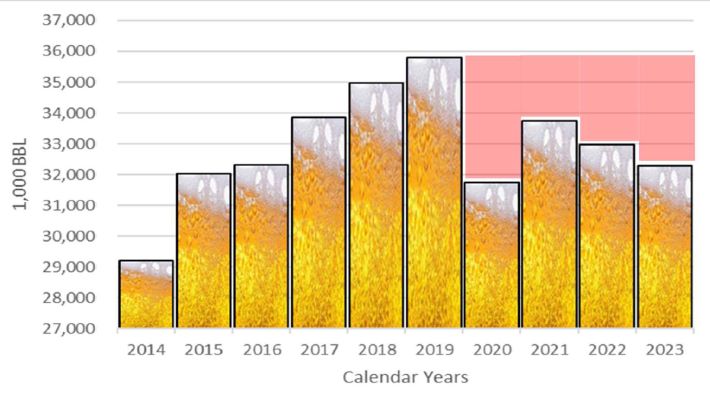
Monday beer links will return next week.

Monday beer links will return next week.

Beer judging: You meet the most interesting beers
If you read Monday’s post before American Homebrewers Association executive director Julia Herz added more about Homebrew HQ at GABF, and the connection between commercial brewers and homebrewers now would be a good time to visit the comments.
I am a big fan of Homebrew Con, even though it is the only place where I’ve seen somebody fall asleep during a presentation I was giving (Baltimore 2016). However, I am down with the idea that “anyone who attends GABF in October as an AHA member will be exposed to an incredible beer and homebrew related experience unique to any other event in the U.S.”
Also, that the National Homebrew Competition awards will be handed out at GABF also has a nice ring to it. Bringing us to the point of this post. The entry window for NHC is open. You may pick which site you want to send your beer to for first round judging. If it is really good, I propose you send it to Denver. That’s where I have signed up to judge.
Programing note: Plenty of words here this week. You might save some for March 4. It will be quiet here then. Perhaps a few photos from the traventine terraces at Yellowstone National Park here or on Instagram. But don’t count on anything timely. Yellowstone does not make internet service a high priority.

As soon as I finished listening to John Holl’s conversation with American Homebrewers Association executive director Julia Herz last week Spotify took me back to music and Molly Tuttle singing “Next Rodeo,” which begins “Well, this ain’t my first rodeo.”
First, what Holl and Herz are talking about:
“Homebrewing has been a source of passionate online chatter over the last week after the American Homebrewers Association announced it would put its annual Homebrew Con on ‘hiatus’ in favor of smaller events and demonstrations located within the Great American Beer Festival in Denver.”
Take the time to listen. Now, about what connects the challenge Herz faces to Tuttle’s song. I will spare you the long version. In December, Good Beer Hunting asked, “What Happens When Craft Beer and Homebrewing Decouple?”
In it, Herz says, “One of the biggest things I’m asked from homebrew club leaders is: How do we attract more young people and women to brew? How do we diversify?”
It will be their first rodeo.
ON WRITING
A life in beer: Invisible gods
and
Who returns a half-read book to Amazon?
Jeff Alworth buried the lead in “A life in beer,” waiting until the last paragraph to write, “I’d like to interrogate my life the way I do breweries, trying to figure out where its meaning lies.” I’m not sure what to expect, but I will be there to watch read.
After Jonathan Eig received a “snarky and arrogant and rude” letter critiquing “King: A life,” his friend Jeff Pearlman reached out to a couple dozen other writers and asked them how they would respond. Some fun reading, as well as interesting insights into how writers may respond to criticism (deserved or otherwise).
YOU MIGHT ALSO ENJOY
Drinking note of the week: ‘Pandora’s box without the hope’
But maybe not the IPA of the week. “A hard, yeasty grit suffuses the flavour in a most unpleasant and unwelcome way. Chalk and boiled vegetables hit first: dry and earthy with a strong and rough bitterness. Some softer peach and banana flashes briefly before the sharp dregs take over once more, seeing us out into a mercifully short finish. . . . Regardless, it’s a poor example of this kind of double IPA, gathering together all the features I dislike and then releasing them simultaneously. Pandora’s box without the hope.”
Lede of the week
“A long time ago, during a time in the craft beer industry that seems far far away, breweries couldn’t keep up with demand. The Sith macro brands were being challenged by rebel start-ups assembling a selling story that included smaller batches, bigger flavor, freshness, and locally made, taking aim at 20% market share by 2020. Camaraderie within this resistance quickly became fractured leading to a period of IPA Wars and many of craft beer’s strongest allies giving in to the dark side. In 2024, the universe remains in a chaotic state of war with craft breweries now seeking out more sophisticated weaponry as they focus simultaneously on attacking the Sith with premium lagers, while improving their own position within the ranks of the rebel craft beer alliance.”
FYI, the post is about beer data, and business oriented. The next is really about business, as well.
Got bacon? Lessons for the wine beer industry
“The product had a long history and was well-loved in America and around the world. But the industry itself was in crisis. Demand was down. Part of the problem was health concerns and part of it was price (its retail price was higher than the most popular substitute). Worse of all, younger consumers were turning away.”
– Lesson One: Re-Education is Difficult
– Lesson Two: The Perils of Generic Marketing
– Lesson Three: Innovation
– The Folly of Complacency
Can any English word be turned into a synonym for drunk?
“Benjamin Franklin got into the act with his 1737 Drinker’s Dictionary, listing 288 words and phrases for denoting drunkenness. By 1975, there were more than 353 synonyms for ‘drunk’ listed in that year’s edition of the Dictionary of American Slang. By 1981, linguist Harry Levine noted 900 terms used as drunkonyms.
“So the sheer number of drunkonyms has been increasing, with BBC culture reporter Susie Dent estimating in 2017 that there are some 3,000 English slang synonyms for being drunk, including ‘ramsquaddled,’ ‘obfusticated,’ ‘tight as a tick,’ and ‘been too free with Sir Richard.'”
A diocese and brewery collaboration – feeding the homeless
“All we need to do is look to the cross. So if the joy of Lent can be found in a beer while feeding the hungry and giving shelter to the homeless, I think God is being glorified in all things.”
Chimay has its own dedicated four tap tower
“It’s 10am on a cold but sunny day in Baltimore, Maryland and I am in line with a few dozen other folks. We are waiting for beer. Modern beer thinking would have you believe we are waiting for the release of a hazy IPA or a barrel aged adjunct stout, but that would be false. We are waiting for Belgian beer.”
A love letter to public libraries
I too have a New York Public Library card, but the real reason I am passing this along to add to the discussion earlier this month about third places.
AND FROM X
A lengthy thread (click on date to open it up) that would have made a fine blog post.
Confessions of a beer cellar nerd, post emptying the beer cellar: a ?
— Andy (@MadBeerAndy) February 20, 2024
 .
.
Hop Queries, which began its life in May 2017 as a newsletter, remains primarily that.
Because a) the email does not always go through, and b) I was looking for a way to make the archives useful, Hop Queries is now also a website.
You’ll find the archives here, and complete recent issues here.

2) How Fair State Brewing Hit Bankruptcy, and How It Plans to Fight Through It
3) Craft Beer Has Been Flat for Eight Years, and Other Notes
4 What we’ve gained and what we’ve lost in a decade of British beer
The first story is behind a paywall, but I found a way around it and you may as well. If not, OK, because in the second, Fair State co-founder Evan Sallee does a better job of answering the question anyway:
“Even talking about a “craft beer bubble” has been a pet peeve of mine. Craft beer is not a bubble; bubbles are a special thing where prices are inflated, and disconnected from the underlying market. Whereas the growth of craft beer has been driven by a consumer demand revolution. There are a lot of breweries competing for limited consumers, but that does not a bubble make.”
The chart at the top draws on slightly different data than Jeff Alworth uses in No. 3. John I. Haas CEO Tom Davis shared it at the American Hop Convention. It tracks production from Brewers Association defined craft breweries plus brands once classified as craft that are now owned by large breweries. The pink on the right represents barrels of beer that would have been sold had sales simply gone flat in 2020, rather than declining, not completely recovering, then declining again. Obviously, that matters a lot to hop growers. When barrels aren’t brewed then hops aren’t used. In this case, about 20 million pounds of them.
Two thoughts. First, indeed, little difference between production in 2015 and 2023. Second, if you draw an arrow from the top of the bar at 2015 to 2019 it looks much different than an arrow drawn from the top of 2019 to 2023. Production might be the same, but something different is going on.
Finally, I haven’t seen figures that compare British craft production in 2015 and today, but Boak & Bailey’s then and now illustrates what happens over time. Additionally, it is a reminder of how beer blogging has changed. This is the sort of post that 10 years ago would have inspired more of the same.
What would you pick from 2014 to pair with thiolized yeast, with hop water, with 19.2-ounce cans?
You might also enjoy
– How Does a Brewery Move Forward After a Racist Incident?
More out of the Twin Cities. “56 Brewing is still navigating the ramifications of the incident nearly three years on. (Their) story of moving forward with purpose and success in an unforgiving digital landscape is a sound roadmap after a devastating incident.”
– Does European beer have an American flavour?
If so, shouldn’t it be spelled “flavor?” Anyway, the premise: “Last year, through a combination of luck, obligation and planning, I managed to visit a random selection of bars and breweries in some of Western Europe’s major and major-ish cities (Copenhagen, Paris, Barcelona, Berlin, Brussels, and Glasgow). In and of themselves, they’re not particularly interesting; as a set, they arguably illustrate some different ways in which craft beer has landed in related but different cultures.”
– This Is Senne’s Valley
“I really dislike if your aroma and your body don’t combine together,” says Senne Eylenbosch, talking about blending. “If it’s too fruity in the nose, and it’s too slow-drinking in the body—because body is also one of the reasons that something is very slow drinking—it fights. It’s not good when the aroma is not in character together with the body.”
– Homebrew – Cheaper than the Pub?
Plenty of math in this post. “One thing though that is really clear to me from this little exercise is that ingredients are not the bulk of the cost of making the beer, it is a the people, equipment, and place to do so.”